


 For a truly enlightening afternoon, I urge you to try a cemetery walk. Held on the fourth Sunday every September,the "Historic Elgin Cemetery Walk" showcases some of the Bluff City Cemetery's famous "residents" coming to life for the day. They describe their lives and deaths in and around the Elgin area. This walking tour lasted approximately
an hour and included dramatizations done by members of the Elgin Historical Society acting as their dead counterparts as they stood near their final resting spots. Come join me as I relive my marvelously odd afternoon.
For a truly enlightening afternoon, I urge you to try a cemetery walk. Held on the fourth Sunday every September,the "Historic Elgin Cemetery Walk" showcases some of the Bluff City Cemetery's famous "residents" coming to life for the day. They describe their lives and deaths in and around the Elgin area. This walking tour lasted approximately
an hour and included dramatizations done by members of the Elgin Historical Society acting as their dead counterparts as they stood near their final resting spots. Come join me as I relive my marvelously odd afternoon.

Walter and Hattie Hemmens talk to the waiting cemetery walkers about their lives among the rich in Elgin.
 We gathered on bleacher-type benches behind the office and waited for our ticket numbers to be called. Approximately twenty-five people were assigned to each group. This allowed each actor time to make his presentation, then prepare for his next guests. As it got closer to the noon start time, one of the volunteers introduced us to a couple of Elgin's most prominent citizens. Walter (1864-1941) and Hattie (1872-1957) Hemmens traveled abroad quite a bit, one time taking an extended year-long trek around the globe. They were dressed in fine clothes; she in an elegant ivory lace outfit, he in a tailored suit, holding an expensive-looking cigar. They were society people, Elgin's upper crust. They reminisced with each other and us while staying completely in character. For about ten minutes they kept us spellbound with their musings of days gone by. They never had children, but wanted to do
something with cultural significance for Elgin with their wealth. Hattie said her will was very specific (Walter died before her) as to how to use
their fortune, and wondered if it was ever built. Today, the Hemmens Cultural Center seats 1200 people, has 11,300 square feet of exhibition space, and is used to host big-name entertainment.
We gathered on bleacher-type benches behind the office and waited for our ticket numbers to be called. Approximately twenty-five people were assigned to each group. This allowed each actor time to make his presentation, then prepare for his next guests. As it got closer to the noon start time, one of the volunteers introduced us to a couple of Elgin's most prominent citizens. Walter (1864-1941) and Hattie (1872-1957) Hemmens traveled abroad quite a bit, one time taking an extended year-long trek around the globe. They were dressed in fine clothes; she in an elegant ivory lace outfit, he in a tailored suit, holding an expensive-looking cigar. They were society people, Elgin's upper crust. They reminisced with each other and us while staying completely in character. For about ten minutes they kept us spellbound with their musings of days gone by. They never had children, but wanted to do
something with cultural significance for Elgin with their wealth. Hattie said her will was very specific (Walter died before her) as to how to use
their fortune, and wondered if it was ever built. Today, the Hemmens Cultural Center seats 1200 people, has 11,300 square feet of exhibition space, and is used to host big-name entertainment.
 As I snapped back into reality, after my first glimpse into the past, the
first group was called. In between sites, our volunteer, Gayle, told us
interesting facts about cemeteries and the symbolism often used. For
example, a palm leaf on a memorial means eternal peace. She pointed out the
types of styles used for headstones, like the pillow style, and explained the
techniques used for getting the desired effect on the marker, such as using
"shell pitching" to create a pleasant rough, almost ruffled background effect
typically on a large stone. The front of the stone is usually finished in
finer detail using the "bas relief" technique. I found a dandy example of
this after the tour with my own surname - Kruse - on it!
As I snapped back into reality, after my first glimpse into the past, the
first group was called. In between sites, our volunteer, Gayle, told us
interesting facts about cemeteries and the symbolism often used. For
example, a palm leaf on a memorial means eternal peace. She pointed out the
types of styles used for headstones, like the pillow style, and explained the
techniques used for getting the desired effect on the marker, such as using
"shell pitching" to create a pleasant rough, almost ruffled background effect
typically on a large stone. The front of the stone is usually finished in
finer detail using the "bas relief" technique. I found a dandy example of
this after the tour with my own surname - Kruse - on it!
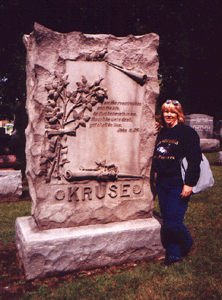
The author poses beside an elegant marker showing excellent use of the "bas relief" and "shell pitching" techniques, with her surname on it!
 When we approached Anna Stani Schrader (1888-1976), she was sweeping a throw
rug laid on the ground next to her grave, with an Elgin sweeper from 1913.
She said she would quit her housework for a while and tell us about her life.
She wove a tale about her happy childhood growing up in Switzerland, but
wanting to come to Elgin as many of her dad's friends had done. There was a
fine watch factory there and she wanted to see America. She finally got her
wish when she was asked to be a maid in Dixon, IL for a friend of her
father's. Eventually, she moved to Elgin and had a family, marrying twice
during her lifetime. With a sweeping gesture, she pointed to her second
husband's grave, musing he was there with us in spirit. When she was done
with her talk, she thanked us for stopping by, but said she must get back to
her housecleaning. Almost like we really had disturbed her, she picked up
her sweeper and immediately went back to work. When we passed her site
later, there was Mrs. Schrader still sweeping. This woman gets my vote for
really knowing how to stay in character!
When we approached Anna Stani Schrader (1888-1976), she was sweeping a throw
rug laid on the ground next to her grave, with an Elgin sweeper from 1913.
She said she would quit her housework for a while and tell us about her life.
She wove a tale about her happy childhood growing up in Switzerland, but
wanting to come to Elgin as many of her dad's friends had done. There was a
fine watch factory there and she wanted to see America. She finally got her
wish when she was asked to be a maid in Dixon, IL for a friend of her
father's. Eventually, she moved to Elgin and had a family, marrying twice
during her lifetime. With a sweeping gesture, she pointed to her second
husband's grave, musing he was there with us in spirit. When she was done
with her talk, she thanked us for stopping by, but said she must get back to
her housecleaning. Almost like we really had disturbed her, she picked up
her sweeper and immediately went back to work. When we passed her site
later, there was Mrs. Schrader still sweeping. This woman gets my vote for
really knowing how to stay in character!
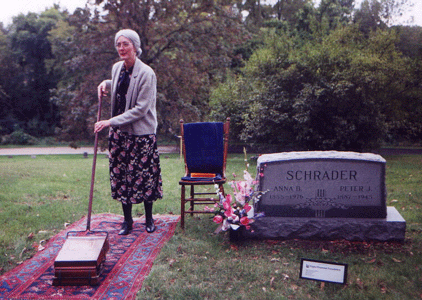
Mrs. Schrader diligently doing her housework using her vintage 1913 Elgin sweeper.
 Next were two gentlemen, Thomas McBride (1810-1888) and Andrew Magnus (1839-1916), buried near each other, separated by the road and a few steps. They both ended up in the ice business together at one time, McBride originally from Ireland, and Magnus from Sweden. They both wore top hats and portrayed their jaunty characters quite well. They were successful
businessmen in life, and did quite well for themselves. Magnus told us of his demise, saying his obituary inferred he worked himself to death during
one particularly hot July.
Next were two gentlemen, Thomas McBride (1810-1888) and Andrew Magnus (1839-1916), buried near each other, separated by the road and a few steps. They both ended up in the ice business together at one time, McBride originally from Ireland, and Magnus from Sweden. They both wore top hats and portrayed their jaunty characters quite well. They were successful
businessmen in life, and did quite well for themselves. Magnus told us of his demise, saying his obituary inferred he worked himself to death during
one particularly hot July.
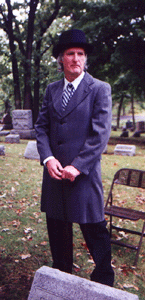
Thomas McBride hailed originally from Ireland.
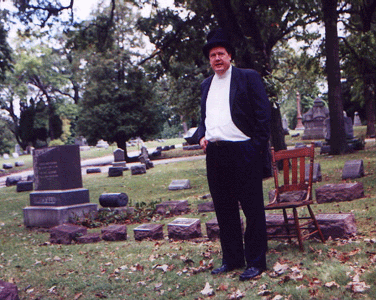
Andrew Magnus moved here from Sweden and worked at one time with Thomas McBride in the ice business.
 We went on to meet the very stern David C. Cook (1850-1927). He played his Sunday school teacher role most convincingly, with greased-back curly hair
and a menacing look, almost scolding us to listen, or else. He wanted to teach us all a lesson, urging us to look for the threads in our lives, and do
some good for humanity based on those threads. His dad was in the printing business, but was also a preacher. After the younger Cook became a preacher,
he opened a Sunday school in Chicago. After the Great Chicago Fire of 1871 wiped the school and print shop out, Cook decided to do something good for
the community, opening three Sunday schools. This proved to be a problem as there was not enough written material for teaching. Drawing on his printing
background, he printed his own lesson plans, eventually selling them to other schools around the country. The first quarter alone he sold 40,000 copies. His family relocated to Elgin, and to this day, the David C. Cook Publishing Co. still operates, providing needed Sunday school material. Rev. Cook
reminded us he'll see us all again someday, on the other side.
We went on to meet the very stern David C. Cook (1850-1927). He played his Sunday school teacher role most convincingly, with greased-back curly hair
and a menacing look, almost scolding us to listen, or else. He wanted to teach us all a lesson, urging us to look for the threads in our lives, and do
some good for humanity based on those threads. His dad was in the printing business, but was also a preacher. After the younger Cook became a preacher,
he opened a Sunday school in Chicago. After the Great Chicago Fire of 1871 wiped the school and print shop out, Cook decided to do something good for
the community, opening three Sunday schools. This proved to be a problem as there was not enough written material for teaching. Drawing on his printing
background, he printed his own lesson plans, eventually selling them to other schools around the country. The first quarter alone he sold 40,000 copies. His family relocated to Elgin, and to this day, the David C. Cook Publishing Co. still operates, providing needed Sunday school material. Rev. Cook
reminded us he'll see us all again someday, on the other side.

John C. Cook was a preacher whose printing company grew to a publishing house due to the need for Sunday school materials.
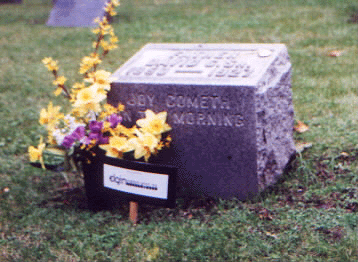
Each participant in the cemetery walk had their gravesite decorated with fresh flowers.
 Hezekiah Gifford (1810-1877) gets my nomination for the best comment of the day. His throat sore and raspy, he quipped, "You would sound like this too,if you spent 123 years in a grave." Mr. Gifford grew up in upstate NY. After the Blackhawk War, returning veterans told of the rich land to be had in the Fox River Valley. After seeing for himself, he convinced his brother
James to sell their land and move there. James is credited with founding the town of Elgin and is buried on the the side of the cemetery. Hezekiah's
first wife, Mary, was considered to be the first white woman in Elgin. Even her tombstone states this unusual fact.
Hezekiah Gifford (1810-1877) gets my nomination for the best comment of the day. His throat sore and raspy, he quipped, "You would sound like this too,if you spent 123 years in a grave." Mr. Gifford grew up in upstate NY. After the Blackhawk War, returning veterans told of the rich land to be had in the Fox River Valley. After seeing for himself, he convinced his brother
James to sell their land and move there. James is credited with founding the town of Elgin and is buried on the the side of the cemetery. Hezekiah's
first wife, Mary, was considered to be the first white woman in Elgin. Even her tombstone states this unusual fact.
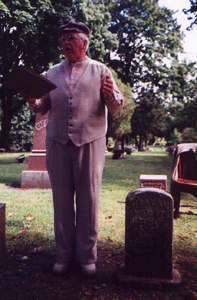
Hezekiah Gifford's brother James founded Elgin in 1835.
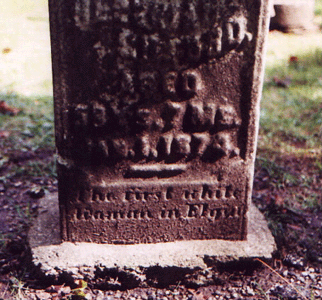
Mary Gifford, wife of Hezekiah, was the first white
woman in Elgin.
 Next up was Thomas Heslin (1835-1920). He was a lamplighter by trade, but
reminded me of a chimney sweep, wearing a short black jacket, with long tails
and a top hat. He reveled in telling us about the days before electric
light, and the day large arc lights finally did come on downtown on November
24, 1883. It was "the" event in Elgin, and must have been quite a sight,
giving her the nickname, "Queen City of the Northwest". He held other jobs
during his lifetime including being a police officer briefly. After the
first scuffle he quit. Sometimes in the summer he worked part-time as a
street sprinkler. The dirt streets of those days needed to be wetted down
regularly to help control the dust. Even though he was well suited for many
jobs, his ultimate ambition was to run his own butcher shop. He finally
realized his dream in 1889, his sons helping him in the shop. This man truly
knew how to experience all Elgin had to offer.
Next up was Thomas Heslin (1835-1920). He was a lamplighter by trade, but
reminded me of a chimney sweep, wearing a short black jacket, with long tails
and a top hat. He reveled in telling us about the days before electric
light, and the day large arc lights finally did come on downtown on November
24, 1883. It was "the" event in Elgin, and must have been quite a sight,
giving her the nickname, "Queen City of the Northwest". He held other jobs
during his lifetime including being a police officer briefly. After the
first scuffle he quit. Sometimes in the summer he worked part-time as a
street sprinkler. The dirt streets of those days needed to be wetted down
regularly to help control the dust. Even though he was well suited for many
jobs, his ultimate ambition was to run his own butcher shop. He finally
realized his dream in 1889, his sons helping him in the shop. This man truly
knew how to experience all Elgin had to offer.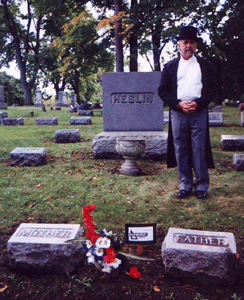
Thomas Heslin was a lamplighter before realizing his dream of running his own butcher shop.
 Our final stop was by Cyrus Larkin (1830-1902). Larkin gleefully greeted us
with pitchfork in hand, dressed in the simple clothes of a farmer, posing for
pictures by the family marker. We listened intently as the story of this
prominent Elgin citizen unfolded. Born in Waterville, VT, his family moved
to a farm in Kane County when he was seven years old. At the age of
nineteen, Larkin took over managing the family farm due to his father's ill
health. He built the farm into a thriving business, investing locally in
banking, and nationally in the cattle business in Texas. Their dairy farm
also supplied the Borden Company with milk for their popular condensed milk
products. His son Fred did well as a doctor, but died unexpectedly. Larkin
wanted his son's name to be remembered, and offered the Elgin Children's Home
a sizable donation if the establishment's name was changed in his son's
honor. Larkin Children's Home still stands today on Larkin Av. It is
interesting to note, Mrs. Schrader, who we met earlier, worked for the
children's home at one time. Larkin High School was built in 1962, on what
used to be part of the family's original farm. While we sat transfixed,
Larkin described the details of his life, then tragic death, a fall from an
80-foot windmill, at the age of 72. He showed us a pocket watch stopped at
9:15, presumed to be the time of his death.
Our final stop was by Cyrus Larkin (1830-1902). Larkin gleefully greeted us
with pitchfork in hand, dressed in the simple clothes of a farmer, posing for
pictures by the family marker. We listened intently as the story of this
prominent Elgin citizen unfolded. Born in Waterville, VT, his family moved
to a farm in Kane County when he was seven years old. At the age of
nineteen, Larkin took over managing the family farm due to his father's ill
health. He built the farm into a thriving business, investing locally in
banking, and nationally in the cattle business in Texas. Their dairy farm
also supplied the Borden Company with milk for their popular condensed milk
products. His son Fred did well as a doctor, but died unexpectedly. Larkin
wanted his son's name to be remembered, and offered the Elgin Children's Home
a sizable donation if the establishment's name was changed in his son's
honor. Larkin Children's Home still stands today on Larkin Av. It is
interesting to note, Mrs. Schrader, who we met earlier, worked for the
children's home at one time. Larkin High School was built in 1962, on what
used to be part of the family's original farm. While we sat transfixed,
Larkin described the details of his life, then tragic death, a fall from an
80-foot windmill, at the age of 72. He showed us a pocket watch stopped at
9:15, presumed to be the time of his death.
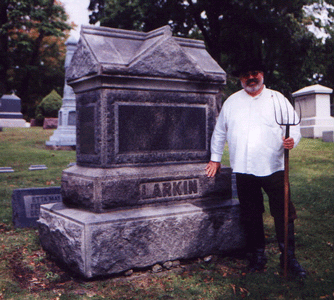
Cyrus Larkin fascinated us with stories of rural life, and his death at the age of 72, due to a fall from a windmill on the family farm.
 After exploring the cemetery a bit more on my own, I finally headed back to
my car, glad I had ventured out on such a cold, gray day. It was an
enjoyable and informative way to slip back and experience the past. I intend
to slide back there again next year.
After exploring the cemetery a bit more on my own, I finally headed back to
my car, glad I had ventured out on such a cold, gray day. It was an
enjoyable and informative way to slip back and experience the past. I intend
to slide back there again next year.

 The Bluff City Cemetery is located at 945 Bluff City Blvd., in Elgin. It was
established in 1899 on 107.8 acres of hilly, cliff-like land. The land could
not be used for planting or building so a cemetery was the natural choice.
There are approximately 43,000 "residents", but the cemetery's capacity is
70,000. To give you an idea of its large size, it takes 1200 man hours to
rake all the autumn leaves. I urge you to take a leisurely walk here on a
crisp, fall day; it's definitely worth the visit.
The Bluff City Cemetery is located at 945 Bluff City Blvd., in Elgin. It was
established in 1899 on 107.8 acres of hilly, cliff-like land. The land could
not be used for planting or building so a cemetery was the natural choice.
There are approximately 43,000 "residents", but the cemetery's capacity is
70,000. To give you an idea of its large size, it takes 1200 man hours to
rake all the autumn leaves. I urge you to take a leisurely walk here on a
crisp, fall day; it's definitely worth the visit.
There's one more. It's my favorite shot at Bluff City Cemetery. It's my ghost.
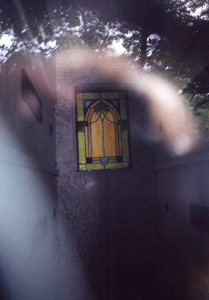
This mausoleum is NOT open to the sky, but certainly appears that way due to reflections.
Notice the "ghost" I
seem to have caught, too.

For more information on how to set up a Cemetery Walk in your area you can contact The Elgin Area Historical Society


Please email Karen Kruse and let her know how much you enjoyed her article! Better yet, for more of Kiki's work, please visit
Ghosts of History Live in Rosehill Cemetery and Milwaukee's Best
To see more of Kiki's cemetery pictures, go to Kiki's
"FindAGrave Credits"



Not just for teacher series pages
| Language Arts |
Science |
My Favorite Links |
Social Studies |
Email: traveler@who.net
